Dear Zazie, Here is today’s Lovers’ Chronicle from Mac Tag dedicated to his muse. Follow us on twitter @cowboycoleridge. Rhett
The Lovers’ Chronicle
Dear Muse,
© copyright 2020 mac tag/cowboy coleridge all rights reserved
flawed till we hold each other
past the view without a sigh
our reflection that we seek,
that we are free, a prelude
of the story untold
the book is open, write it now
we will know how, from awe,
arrive and not miss anymore
from you, all that rises
breathe
© Copyright 2019 Mac tag/cowboy Coleridge all rights reserved
no limits
but the imagination
wine, book, and candle
sing away sorrow
cast away care
a fine one for leapin’
without lookin’
lettin’ the best or worst
come as it will
never believed
in raisin’ a hue or cry
to withdraw is not
to run away
to stay is no wise choice
when there is more reason
to reckon with than hope
perhaps i am a fool,
but with limitations known,
i look forward to tomorrow
as is
© copyright 2018 mac tag/cowboy coleridge all rights reserved
| Miguel de Cervantes | |
|---|---|
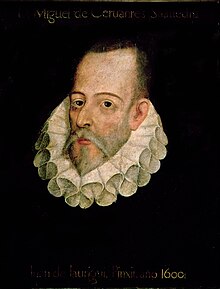
Cervantes
(The portrait supposedly by Juan de Jáuregui. It has not been authenticated, and no authenticated visual image exists.) |
|
Today is the birthday of Miguel de Cervantes Saavedra (Alcalá de Henares; 29 September 1547 (assumed) – 22 April 1616 Madrid); writer who, in my opinion, is the greatest writer in the Spanish language and one of the world’s pre-eminent novelists. His major work, Don Quixote, considered to be the first modern novel, is a classic of Western literature. His influence on the Spanish language has been so great that the language is often called la lengua de Cervantes (“the language of Cervantes”). He has also been dubbed El príncipe de los ingenios (“The Prince of Wits”). In 1569, in forced exile from Castile, Cervantes moved to Rome, where he worked as chamber assistant of a cardinal. He then enlisted as a soldier in a Spanish Navy infantry regiment and continued his military life until 1575, when he was captured by Barbary pirates. After five years of captivity, he was released by his captors on payment of a ransom by his parents and the Trinitarians, a Catholic religious order, and he subsequently returned to his family in Madrid.
In 1585, Cervantes published a pastoral novel named La Galatea. He worked as a purchasing agent for the Spanish Armada, and later as a tax collector for the government. In 1597, discrepancies in his accounts for three years previous landed him in the Crown Jail of Seville. In 1605, he was in Valladolid when the immediate success of the first part of his Don Quixote, published in Madrid, signalled his return to the literary world. In 1607, he settled in Madrid, where he lived and worked until his death. During the last nine years of his life, Cervantes solidified his reputation as a writer; he published the Novelas ejemplares (Exemplary Novels) in 1613, the Journey to Parnassus (Viaje al Parnaso) in 1614, and the Ocho comedias y ocho entremeses and the second part of Don Quixote in 1615. His last work Los trabajos de Persiles y Sigismunda (The Works of Persiles and Sigismunda) was published posthumously, in 1617.
Prose
Don Quixote de la Mancha (1605–1615)
Part I
Book I
- En un lugar de la Mancha, de cuyo nombre no quiero acordarme, no hace mucho tiempo que vivía un hidalgo de los de lanza en astillero, adarga antigua, rocín flaco y galgo corredor.
- In some village in La Mancha, whose name I do not care to recall, there dwelt not so long ago a gentleman of the type wont to keep an unused lance, an old shield, a skinny old horse, and a greyhound for racing.
- Ch. 1.
- In some village in La Mancha, whose name I do not care to recall, there dwelt not so long ago a gentleman of the type wont to keep an unused lance, an old shield, a skinny old horse, and a greyhound for racing.
La pluma es la lengua del alma: cuales fueren los conceptos que en ella se engendraren, tales serán sus escritos.
- The pen is the tongue of the soul: and the concepts engendered there, such will be written.
- Ch. 16, as translated by Henry Edward Watts (1895).
Nadie nace enseñado, y de los hombres se hacen los obispos, que no de las piedras.
- No man is born wise. Bishops are made of men and not of stones.
- Ch. 33.
- de todos ha de haber en el mundo (literally, “There must be of all [types] in the world”)
- Ch. 6
| Caravaggio | |
|---|---|
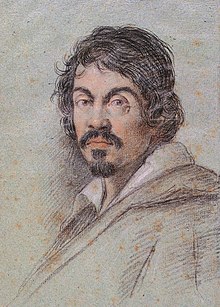
Chalk portrait of Caravaggio by Ottavio Leoni, circa 1621.
|
|
Today is the birthday of Michelangelo Merisi (Michael Angelo Merigi or Amerighi) da Caravaggio (Milan, Duchy of Milan, Spanish Empire; 29 September 1571 – 18 July 1610 Porto Ercole, Grand Duchy of Tuscany): painter active in Rome, Naples, Malta, and Sicily between c1592 and 1610. His paintings, which combine a realistic observation of the physical and emotional human states, with a dramatic use of lighting, had a formative influence on Baroque painting. Caravaggio trained as a painter in Milan under Simone Peterzano who had himself trained under Titian. In his twenties Caravaggio moved to Rome where there was a demand for paintings to fill the many huge new churches and palazzos being built at the time. It was also a period when the Church was searching for a stylistic alternative to Mannerism in religious art that was tasked to counter the threat of Protestantism. Caravaggio’s innovation was a naturalism that combined close physical observation with a dramatic, even theatrical, use of chiaroscuro which came to be known as tenebrism (the shift from light to dark with little intermediate value). He gained attention in the art scene of Rome in 1600 with the success of his first public commissions, the Martyrdom of Saint Matthew and Calling of Saint Matthew. Thereafter he never lacked commissions or patrons, yet his life was tumultuous. He was jailed on several occasions, vandalized his own apartment, and ultimately had a death sentence pronounced against him by the Pope after killing a young man, possibly unintentionally, on May 29, 1606. An early published notice on him, dating from 1604 and describing his lifestyle three years previously, recounts that “after a fortnight’s work he will swagger about for a month or two with a sword at his side and a servant following him, from one ball-court to the next, ever ready to engage in a fight or an argument, so that it is most awkward to get along with him.” In 1606 he killed a young man in a brawl and fled from Rome with a price on his head. He was involved in a brawl in Malta in 1608, and another in Naples in 1609, possibly a deliberate attempt on his life by unidentified enemies. This encounter left him severely injured. A year later, at the age of 38, he died under mysterious circumstances in Porto Ercole in Tuscany, reportedly from a fever while on his way to Rome to receive a pardon.
Famous while he lived, Caravaggio was forgotten almost immediately after his death, and it was only in the 20th century that his importance to the development of Western art was rediscovered. Despite this, his influence on the new Baroque style that eventually emerged from the ruins of Mannerism was profound. It can be seen directly or indirectly in the work of Rubens, Jusepe de Ribera, Bernini, and Rembrandt, and artists in the following generation heavily under his influence were called the “Caravaggisti” or “Caravagesques”, as well as tenebrists or tenebrosi (“shadowists”). The 20th-century art historian André Berne-Joffroy claimed: “What begins in the work of Caravaggio is, quite simply, modern painting.”
Caravaggio never married and had no known children, and his work is absent any female nudes. Nevertheless, a connection with a girl named Lena is mentioned in a 1605 court deposition by Pasqualone, where she is described as “Michelangelo’s girl”. Lena was reportedly Caravaggio’s model for the Madonna di Loreto. Lena may have been the courtesan Maddalena di Paolo Antognetti, who named Caravaggio as an intimate friend by her own testimony in 1604. Caravaggio also probably enjoyed close relationships with other courtesans such as Fillide Melandroni, of whom he painted a portrait.
Gallery
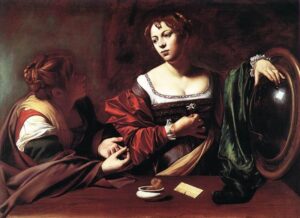










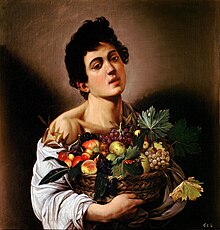





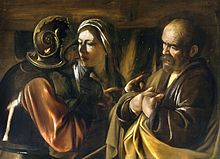

| François Boucher | |
|---|---|

Portrait of François Boucher by Gustaf Lundberg (1741)
|
|
Today is the birthday of François Boucher (Paris; 29 September 1703 – 30 May 1770 Paris); painter, draughtsman and etcher, who worked in the Rococo style. Boucher is known for his idyllic and voluptuous paintings on classical themes, decorative allegories, and pastoral scenes. He was perhaps the most celebrated painter and decorative artist of the 18th century. He painted several portraits of his patroness, Madame de Pompadour.
Boucher married Marie-Jeanne Buzeau in 1733.
Boucher said that nature is “trop verte et mal éclairée” (too green and badly lit). A licentious style can be seen in his Odalisque portraits. The dark-haired version of the Odalisque portraits prompted claims that Boucher was “prostituting his own wife”, and the Blonde Odalisque was a portrait that illustrated the extramarital relationships of the King. Boucher gained lasting notoriety through such private commissions for wealthy collectors and, after Diderot expressed his disapproval, his reputation came under increasing critical attack during the last years of his career.
Gallery
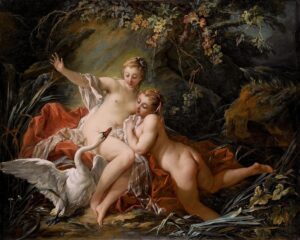
Léda et le cygne


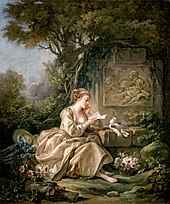
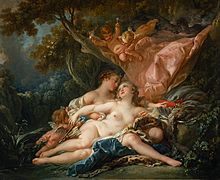

-

Self-portrait in the Studio, 1720, Louvre
-

Putti with Birds, c. 1730-1733, Honolulu Museum of Art
-
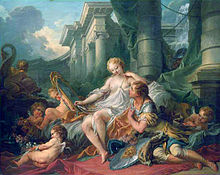
Rinaldo and Armida, 1734
-

Diana Leaving the Bath 1742
-

Venus Consoling Love 1751
-

The Toilet of Venus (1751) typifies the pleasing elegance of Boucher’s mature style.
-

The Bridge, 1751, Louvre
-

Madame de Pompadour, 1756, Alte Pinakothek
-

Saint Peter Attempting to Walk on Water, 1766, Cathédrale Saint-Louis, Versailles
-

Dreaming Shepherdess
-

Autumn Pastoral
-

Vulcan Presenting Venus with Arms for Aeneas


Mac Tag

No Comments on "The Lovers’ Chronicle 29 September – as is – birth of Miguel de Cervantes Saavedra – art by Caravaggio & François Boucher"